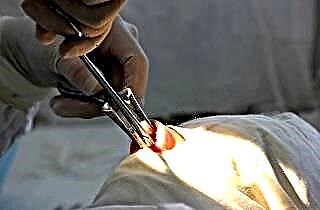Suppuration, or otorrhea, is one of the symptoms of the development of acute purulent inflammation of the middle ear. It indicates a perforation of the tympanic membrane, since the exudate accumulated as a result of inflammation puts pressure on the tympanic membrane, leading to its perforation. The presence of this symptom characterizes the development of the perforated stage of acute purulent otitis media. In the case of a successful course of the disease and the absence of complications, the subsequent development of reparative processes is characteristic, during which the integrity of the tympanic membrane is restored and hearing returns.
Suppuration is not a necessary symptom. Often, the accumulated pus leaves the cavity not by breaking the tympanic membrane, but finds a way out through the auditory tube. The appearance of otorrhea is accompanied by an additional change in the clinical picture. There is a decrease in body temperature, an improvement in general condition, a decrease in pain.
Activities at the pre-performance stage
 However, the development of this symptom was preceded by 2-3 days, and sometimes a week of malaise, an increase in body temperature to 39 degrees, severe pain and tinnitus, that is, all the symptoms characteristic of acute otitis media.
However, the development of this symptom was preceded by 2-3 days, and sometimes a week of malaise, an increase in body temperature to 39 degrees, severe pain and tinnitus, that is, all the symptoms characteristic of acute otitis media.
In order for the disease not to turn into a chronic form and its severe complications do not develop, treatment should be started precisely at the pre-perforative stage..
Therapeutic measures during this period should be as follows:
- the use of ear drops, which include anesthetics, analgesics and antiseptics;
- with severe pain syndrome, it is possible to use non-steroidal anti-inflammatory drugs inside;
- the use of warming procedures;
- the use of nasal drops with a vasoconstrictor effect;
- if there is a pronounced protrusion of the tympanic septum, the specialist may decide to carry out paracentesis.
Among the ear drops most preferred during this period, Otipax is used. The drug contains a non-steroidal anti-inflammatory drug and a local anesthetic lidocaine. An analgesic effect is also achieved by prescribing a 3% alcoholic solution of boric acid. All ear drops before instillation should be warmed up to body temperature, and the ear canal after the procedure should be closed with a cotton swab.
 Of the non-steroidal anti-inflammatory drugs, the use of which is possible in this case, the most popular are paracetamol and ibuprofen. In addition to analgesic, these agents have antipyretic and anti-inflammatory effects, which can also help improve the condition. Vasoconstrictor nasal drops are also necessary in the treatment of this pathology, since in most cases the development of otitis media is associated precisely with diseases of the nasopharynx, and is due to the spread of purulent contents into the tympanic cavity through the auditory tube. The use of nasal drops such as sanorin, naphthyzin, galazolin interferes with this process.
Of the non-steroidal anti-inflammatory drugs, the use of which is possible in this case, the most popular are paracetamol and ibuprofen. In addition to analgesic, these agents have antipyretic and anti-inflammatory effects, which can also help improve the condition. Vasoconstrictor nasal drops are also necessary in the treatment of this pathology, since in most cases the development of otitis media is associated precisely with diseases of the nasopharynx, and is due to the spread of purulent contents into the tympanic cavity through the auditory tube. The use of nasal drops such as sanorin, naphthyzin, galazolin interferes with this process.
As for the warming procedures, alcohol compresses, heating pads, and UFO lamps can be used to treat purulent otitis media at home. During this period, you can warm your ear with purulent otitis media. The procedure should be postponed immediately if the pain increases sharply, which may be associated with the development of complications.
In the event that the therapeutic measures carried out did not give an effect, there was no positive dynamics in the patient's condition, antibiotics should be added to the treatment. The absence of suppuration indicates that local antibiotics cannot be used, since the drug will not be able to penetrate the intact tympanic membrane and exert its therapeutic effect. The drugs of choice used in this stage of treatment of purulent otitis media in adults are the antibiotic amoxicillin and its analogues, Flemoxin, Ospamox, Hikontsil, taken in the form of tablets.
Perforation activities
Despite the ongoing treatment, after a few days from the onset of the disease, the patient sometimes has pus flowing from the ear. What to do in this case? It all depends on where the patient is and how quickly qualified assistance can be provided. In this case, consultation with an otolaryngologist is necessary to adjust the treatment tactics.
Features of the use of drugs in the treatment of acute purulent otitis media in this period are that at this stage the intake of alcohol-containing drops is contraindicated, since this substance can have a toxic effect on the mucous membrane of the tympanic membrane and lead to a deterioration in the condition. The same effect is possessed by products containing anti-inflammatory components. Otipax drops are already contraindicated in this period.
The use of warming procedures during this period is categorically excluded.
Measures for suppuration
In addition, the evacuation of pus from the ear canal plays an important role in the treatment of acute purulent otitis media. It will be more correct if a specially trained nurse of the ENT department is involved in this process. In the event that the treatment of purulent otitis media occurs at home, then the procedure should be carried out carefully, using only cotton wool twisted in a spiral. The use of matches, knitting needles and factory-made ear sticks is strictly prohibited. The eardrum is damaged, and awkward movement can lead to additional trauma or infection of the skin of the external ear canal. This procedure is carried out 2-3 times a day, until the exudate is removed and the cotton wool becomes dry.
In cases where the secret is very thick, with purulent otitis media, you can rinse the ear with a 3% solution of hydrogen peroxide. This will facilitate the evacuation of the contents. After the procedure, the ear canal must be dried. Saline can be used as a means used to hold a toilet in the external auditory canal.
As for the use of drugs, topical preparations in the form of ear drops should be added to the antibiotics in tablet form. In this case, such drops containing antibiotics are widely used:
- Otofa,
- Tsipromed,
- Normax.

It is recommended to instill drops after rinsing and drying the ear, warming them to body temperature. Turning to the use of combined funds, it is necessary to pay attention to the composition of the components included in them, since the content of alcohol, non-steroidal anti-inflammatory components with perforation of the tympanic membrane is unacceptable.
Many experts in the treatment of purulent otitis media in adults suggest using the injection method for instilling ear funds. To do this, after instilling the ear, it is necessary to press on the tragus with a finger, closing the lumen of the external auditory canal, and make movements that promote the penetration of the drug into the middle ear. After a while, the patient should feel the taste of the medicine in the mouth. In this case, it is considered that the procedure was carried out correctly, and a more targeted effect of the drug is provided.
Antibiotic therapy should be continued for at least 7-10 days, even if the condition is normal and there are no clinical manifestations of the disease.
Otherwise, there is a high risk of relapse, the transition of the disease into a chronic form, when it comes to surgical methods of treatment. It should be remembered that a number of antibiotics have an ototoxic effect. Using these ear drops can cause hearing loss.
At the subsequent, reparative stage, the treatment of acute purulent otitis media consists in carrying out procedures that promote the healing and restoration of the elasticity of the tympanic membrane. For this, procedures such as pneumomassage, iontophoresis with lidase can be prescribed.
Outcome of suppuration
Otorrhea usually lasts for several days, after which there is a persistent improvement in the condition, and the return of hearing. In the event that, in the presence of a perforation of the tympanic membrane, the patient's condition has not improved, one can assume the development of a complication, inflammation of the mastoid process. A worsening condition after a period of improvement may also indicate the presence of mastoiditis.
A formidable complication of the disease may be indicated by the presence of suppuration for a long time, more than 3-4 weeks. In this case, we can talk about empyema of the mastoid process or extradural abscess. With such a development of the situation, there can be no talk of treatment at home. The patient should be admitted to a specialized hospital, and further treatment should be carried out under the direct supervision of an otolaryngologist.
Thus, what to do if the ear festers depends on the presence of accompanying symptoms and their dynamics. Improvement of the patient's condition with the appearance of otorrhea indicates a perforated stage of purulent otitis media. In this case, correction of the treatment and measures to evacuate the contents of the external auditory canal are required. In the event that suppuration did not bring relief, severe pain in the ear, dizziness, hyperthermia are still worried, then immediate specialist help is required in the conditions of the ENT department. In this case, we can talk about the development of complications of the disease.



